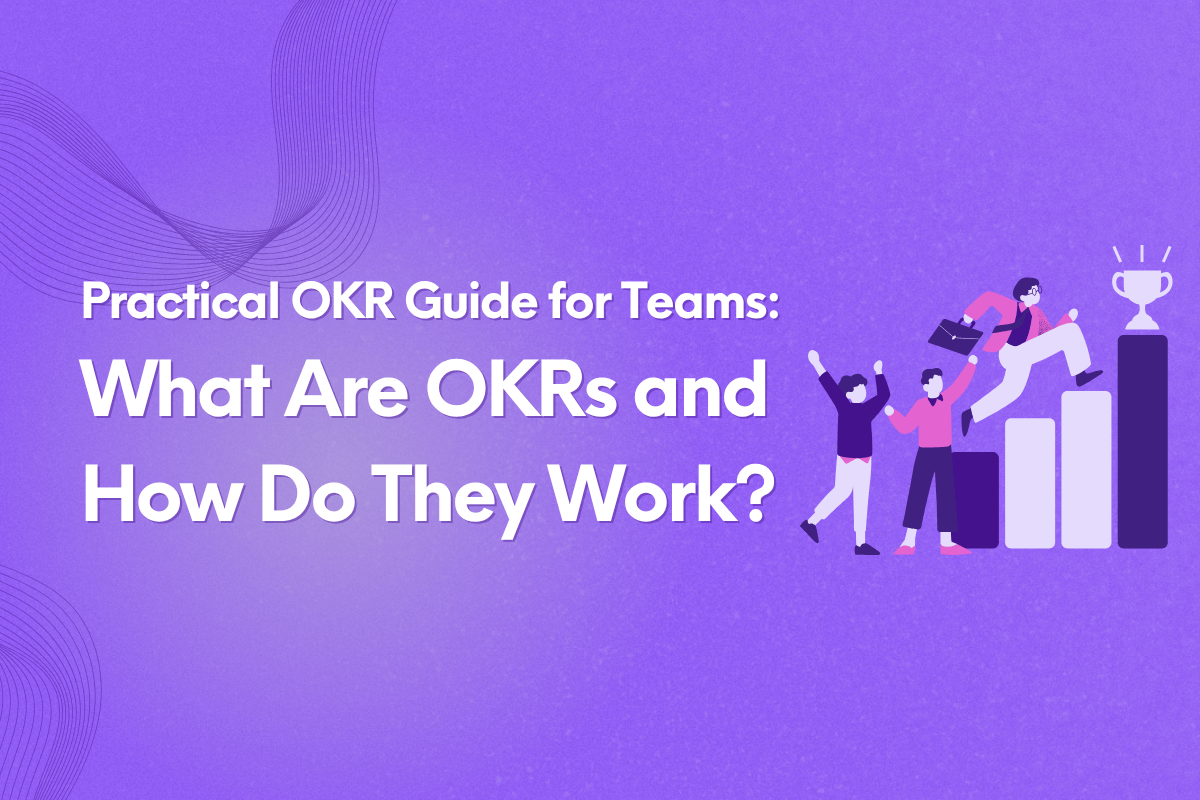The first step to achieving success is to actually define it. But it's not something as simple as declaring an outcome. After all, success is often measured by intangible factors. For businesses, it might be financial indicators such as sales or ROI.
In project management and software development, success is even harder to measure. Because you can complete a project, but how do you consider it as successful?
Alignment, focus, and moving in the same direction are essential for teams. Clear direction and measurable goals help you stay on track and achieve success. Otherwise, teams might get trapped or lose their way along the process.
This is where OKRs come in. With a framework, your team stays aligned and executes processes that show key results. Team members can see the long-term vision, which helps with task management and prioritization. In this blog, we deep dive into what OKRs are, how they work, and the best practices when setting OKR frameworks.
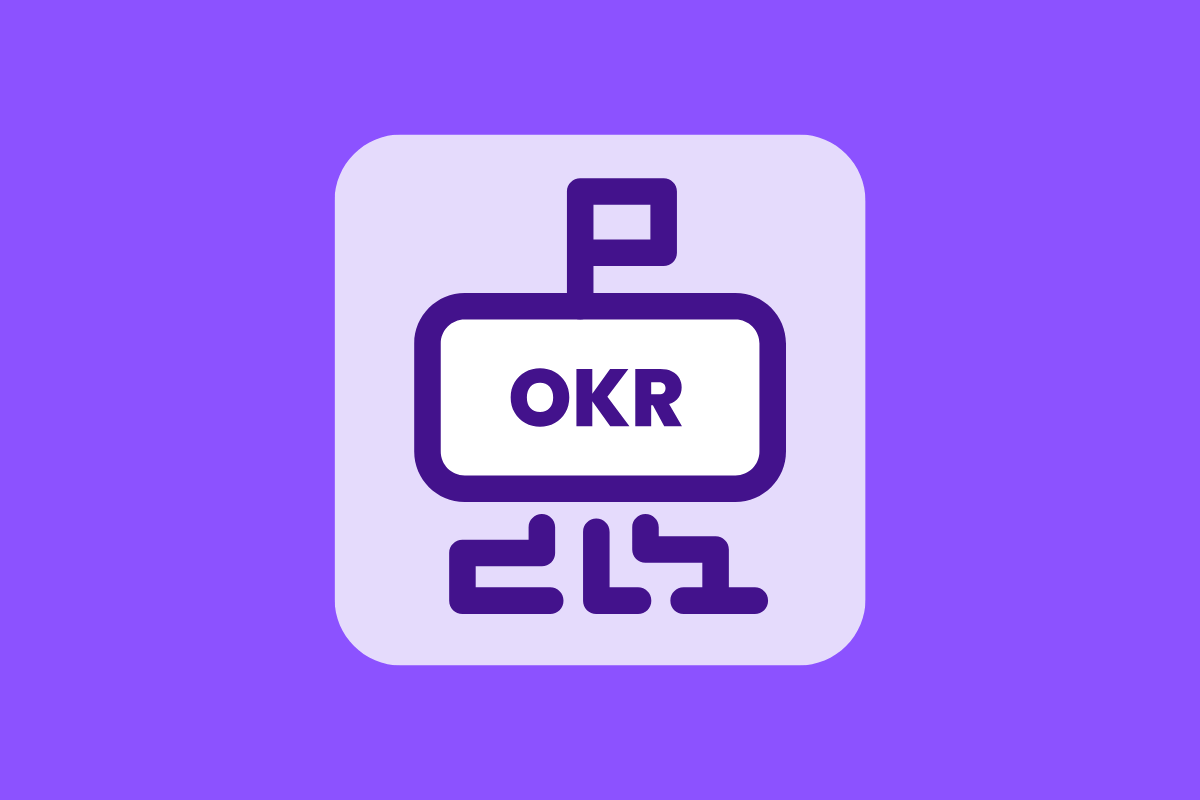
What Is An OKR?
OKR stands for Objectives and Key Results. It is a framework that helps organizations and teams define and track measurable goals. OKR methodology bridges the gap between objectives and concrete actions, helping teams turn vision into quantifiable results.
- Objective: What your team wants to achieve, often ambitious and qualitative. Your objectives should provide direction and purpose. They answer the question, "What do we want to accomplish?"
- Key Results: How progress is measured through specific, quantitative, and time-bound metrics. Key results should also be realistic and achievable. They answer the question, "How do we know we're getting there?"
A Brief History of OKRs
The beginning of OKR's history can be traced back to Peter Drucker, who introduced Management by Objectives (MBO) in the 1950s. Its purpose was to set measurable goals that employees and managers/supervisors can agree on, focusing on a collaborative approach.
However, MBO has weaknesses that are effectively addressed in the OKR goal-setting framework. In the 1970s, Andrew Grove took the concept of MOB and improved it to OKRs at Intel. In the 1990s, John Doerr also spread OKRs to Google, which made the concept even more effective, and consequently, led to its use in the tech industry and other sectors worldwide.
Differences Between OKRs and KPIs
It’s actually pretty common for people to mistake OKRs with KPIs (Key Performance Indicators) because both are metrics used by teams. However, their purposes differ, and if your team understands the difference, they will be in a better position to use both methods more effectively.
Read More: KPIs vs. OKRs: Key Differences
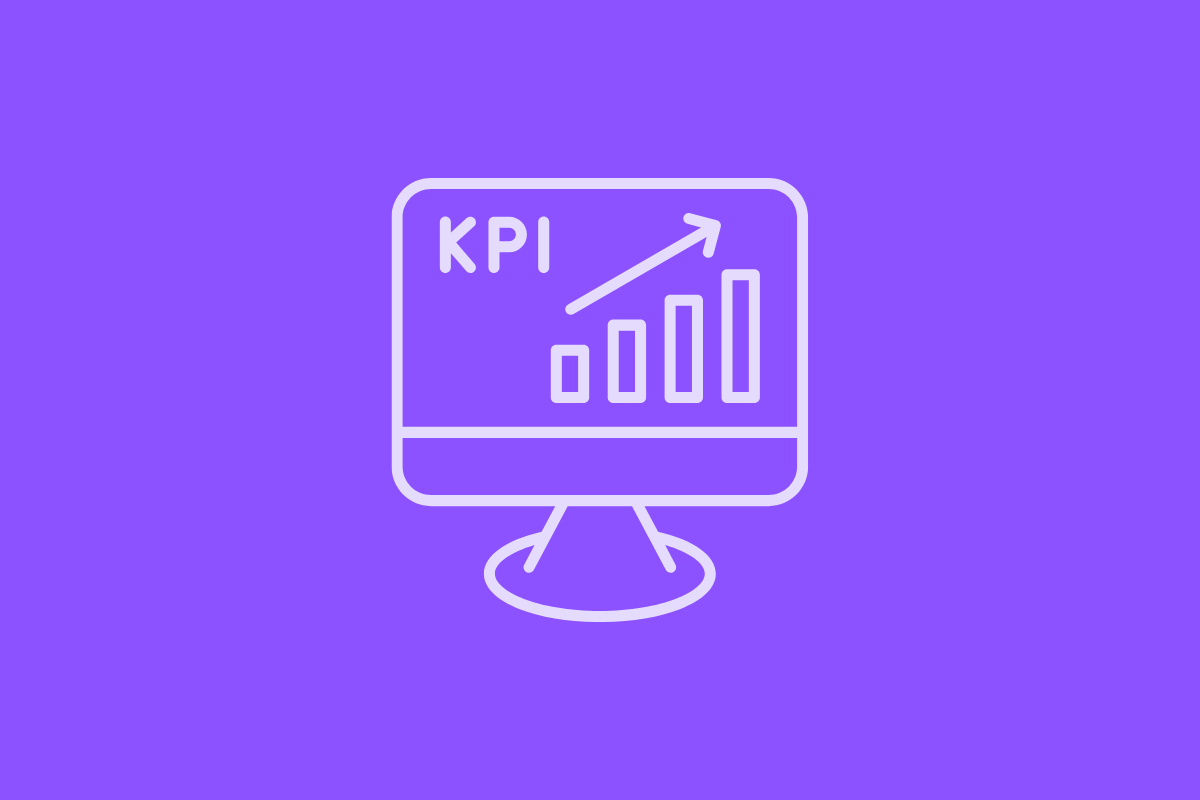
Purpose and Application
OKRs and KPIs have significant differences in terms of purpose and application. While KPIs are considered metrics for measuring the current health of a system, OKRs are geared towards pushing for change and growth.
KPI measures the ongoing performance of systems and operations against established benchmarks. One example would be a website's page speed. On the other hand, OKR focuses on improving through ambitious goals. In terms of the website, it could be optimized for the user experience through personalization.
Timeframe
KPIs are measured continuously since they are used to track and monitor the health of a system or an organization's processes. Meanwhile, OKRs are short-term and often implemented quarterly.
Nature
The nature of OKRs and KPIs is vastly different. While OKRs are more ambitious and goal-oriented, KPIs are simply metrics that help assess the current state of processes or systems. Teams use the former to push for constant innovation and improvement, while the latter is more about maintaining steady progress and is often performance-based. Setting OKRs can help your team achieve high-impact goals, while using KPIs can help spot potential bottlenecks.
Focus
Teams set KPIs to get a good view of how healthy or effective the current system is. It focuses on the present, assessing the need for incremental improvements or, generally, just maintaining the existing processes. OKRs are future-oriented and give organizations direction on where they should go.
Why OKRs Matter for Teams and Businesses
If you’ve been using traditional methods for setting goals like KPIs and to-do lists, you might see steady growth. However, without setting OKRs, you might be falling behind against competition. With effective OKRs, you do not only focus on the process but also the outcome. Here’s why OKRs matter for teams and businesses.

Focus and Commitment
Instead of wasting time and effort trying to get everything done at once, OKRs guide your team to prioritize and commit to important objectives. This will help prevent a sense of overwhelm while also removing distractions. A general rule of thumb for OKRs is to only set 3-5 objectives.
Read More: Top Tips for Prioritizing Your Workload and Boosting Productivity
Alignment Across Teams
Individual efforts contribute to the overall goals of an organization. One of the benefits of OKRs is that each team member can see how their work is connected. It also gives clarity on the priorities.
One example would be a company that wants to increase revenue by 30%. The sales team’s OKRs should focus on increasing customer retention by 40%, and the product development team’s OKR would be more about launching features that improve retention.
Accountability and Transparency
What makes OKR truly effective is that it is measurable. It's easy for entire organizations to see and track progress towards goals. It gives project managers or dev leadership insight into performance for data-driven evaluation. With this, you can adjust the priorities as needed or reallocate resources.
Motivates Teams for Growth
Teams feel more motivated when they see concrete results of their work. With OKRs, you can see that your efforts have a meaningful impact. OKRs also drive your team to grow more and get out of comfort zones by chasing ambitious goals. When you follow OKR management framework, you should embrace the belief that achieving 70-80% of ambitious goals is considered better than having a 100% completion rate of conservative goals.
Agility
OKRs are more agile than traditional annual planning. They are often set and implemented quarterly, helping businesses and teams adapt to changing circumstances while also keeping focus on priorities.
The Core of Effective OKR
How effective OKRs are depends on how well you understand and implement their core. Here are the core components of OKR and some examples.

1. Objective — The What
Objectives are the things that your team wants to achieve. When setting objectives, make sure that they are clear, qualitative, and inspirational. They should answer the questions "What do we want to achieve?" and "Where do we want to go?" Strong objectives have the following characteristics:
- Qualitative: Objectives should be inspiring and paint a rich picture of what you want to achieve.
- Time-bound: Set a timeline, typically quarterly or annual periods.
- Actionable: Easy to understand and gives a concrete idea of what to do.
- Aligned: Supports the overall goal of the company or organization.
Weak Objective Examples:
- Improve the website.
- Respond to inquiries faster.
- Increase brand awareness.
Strong Objective Examples:
- Improve website traffic by 20% by Q2.
- Deliver faster support and enhance customer satisfaction by reducing response times.
- Achieve significant brand recognition and establish the brand as a thought leader.
2. Key Results — The How
If objectives are the goal, key results are the metrics that you use to measure how well you are progressing towards the goal. They should be specific, measurable, and verifiable. Your team members should be able to easily identify and determine whether key results are achieved. It’s recommended to set 3-5 key results per objective.
These are the qualities of strong key results:
- Specific and measurable: While objectives are qualitative, key results are quantitative. It should include numbers or percentages, data that can be measured.
- Achievable: Key results should require significant effort but should still be achievable.
- Verifiable: Should be data-driven and not based on opinions.
- Outcome-focused: Focuses on results that can be measured and not activities.
Weak Key Results Examples:
- Increase social media engagement.
- Reduce page load time.
- Achieve more than 500 users.
Strong Key Results Examples:
- Achieve 1,000 active users within three months of launch.
- Reduce page load time to under 2 seconds.
- Get a 4.5/5 rating for the product in Google Play Store.
Best Practices for Implementing OKRs
If you want to implement OKRs successfully, you need to maximize their effectiveness. It's not only about having good OKRs or measurable key results. You need to cultivate the right mindset and adopt proven best practices when implementing OKRs.

Start Small
Innovation should start small. There's no need to change the entire system or processes overnight. Start within your team or department and gradually expand your effort to a large scale. You can improve as you learn from the experience.
Embrace the 70-80% Rule
When you're consistently achieving 100% of OKRs, you're probably not setting more ambitious ones. They are designed to be challenging and innovative. Set OKRs that represent exceptional performance with a 70-80% completion rate.
Be Transparent
One of the things that make OKRs effective is transparency. It allows each individual within the team or organization to see and understand priorities. With the visibility, your team can collaborate better and see how each work connects.
Encourage Growth and Learning
Because OKRs are ambitious and challenging, it's important to understand that you will not achieve them fully. But it doesn't mean that you or your team are failing. Missed OKRs are learning opportunities. Make them a motivation to grow and continue learning.
Keep Them Simple
Using complex metrics or complicated words can confuse your team. Keep them simple, clear, and inspiring so they can easily picture what you want to achieve.
Common OKR Mistakes to Avoid
The whole point of setting OKR is to grow, innovate, and achieve ambitious goals. And even with lots of experience, your team can still make mistakes when implementing OKRs for the first time. What’s important is to develop awareness and learn from the experience. Here are some common mistakes you should avoid.
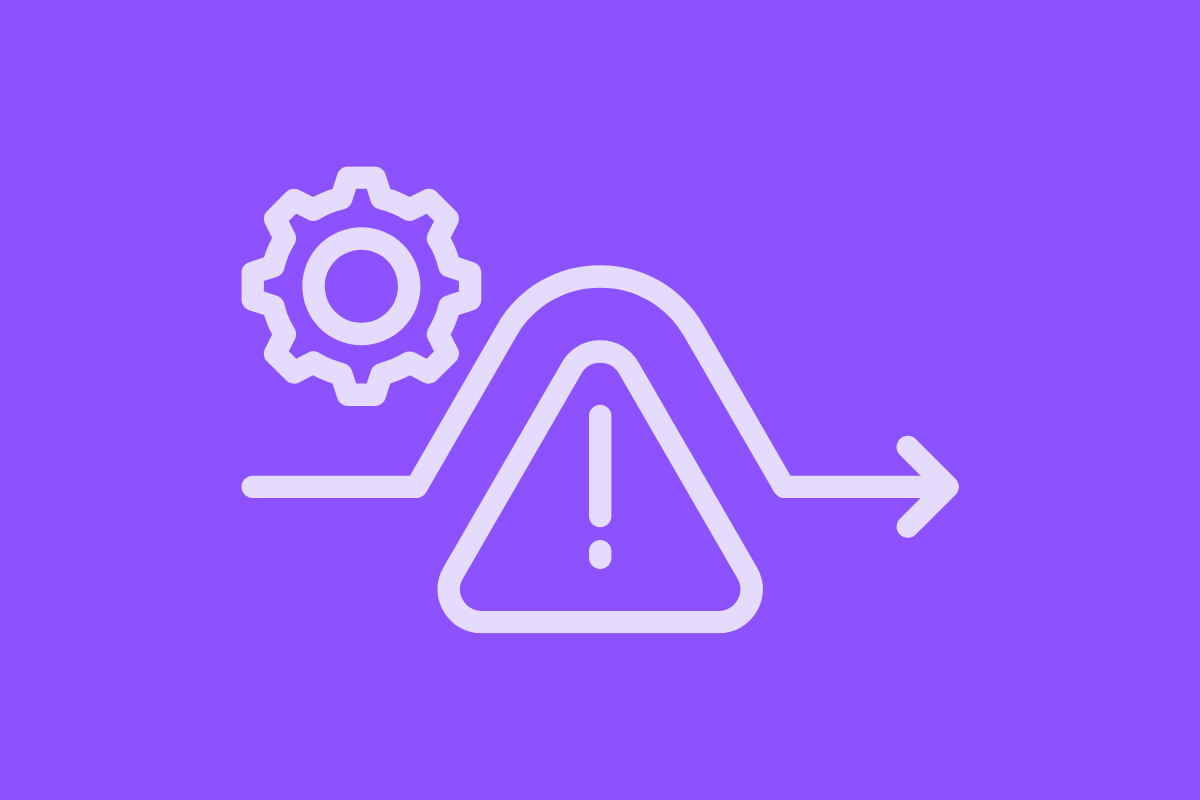
1. Setting Too Many OKRs
To maintain focus and clarity, the ideal approach is to limit objectives to 3-5, with each objective supported by 3-5 key results. In this case, more is not better, and it just spreads your resources too thin.
2. Key Results Are Too Vague
Using verbs for key results makes it easier to establish actionable steps. However, if you don't attach a number to each action, they can be vague. Key results should be measurable. For example, key results with words like "increase", "reduce" should also mention specific numbers.
3. Confusing Actions with Key Results
In relation to key results being too vague, one of the common mistakes teams make is confusing them with actions or tasks. Make sure that key results focus on outcomes and not actions or activities.
4. Not Reviewing Regularly
The OKR framework is agile and future-oriented. It helps the team adapt to changes and adjust the course of action while making sure that they stay on track. However, without regular check-ins, it's easy to lose momentum or encounter obstacles.
5. Setting Isolated OKRs
Alignment is a significant benefit of OKR, but some teams and organizations make the mistake of setting large-scale OKRs only with the management's input. It's important to have team members contribute to ensure alignment and ownership of tasks.
How to Implement OKRs: Step-by-Step Process
After you understand the basic principles and components of OKR, you'll be able to set effective objectives and key results to help you or your team achieve success. It may seem intimidating at first, but you can follow a clear roadmap to make it easier. Here's how to get started with effective OKR implementation.

Step 1: Define Your Team Vision
You should have a clear vision of what you want to achieve with your team. It should also align with the broader vision of your company or department.
Step 2: Choose 3-5 High-Impact Objectives
Make sure that your objectives are ambitious, challenging, and have high impact. Keep them short, only 3-5 objectives. Having more doesn't mean you're productive or operating effectively. Sometimes, it only leads to confusion.
Step 3: Define 2-5 Measurable Key Results Per Objective
Set 2-5 key results that support each objective. They should be measurable and show progress clearly. You can include percentages, numbers, or milestones as metrics that can be quantified.
Step 4: Align and Assign Ownership
When setting OKRs, align with other teams, your department, or the company. Make sure that they are connected and also have a clear owner. Identify which teams or individuals are responsible for the success of each OKR. This helps provide clarity on progress.
Step 5: Review Progress Regularly
Since OKR is ambitious, it's important to review your progress regularly. Check-ins help you spot possible issues in the workflow like bottlenecks or processes that you can adjust. There are project management tools, such as Leiga, that can help visualize the progress of OKRs.
Step 6: Reflect and Reset
If you set quarterly OKRs, make sure that you're evaluating at the end of each quarter. List how many key results are completed and if there are any lessons you can adopt and carry into the next cycle. Keep in mind that it's ok not to have a 100% completion rate, embrace the 70-80% instead.
Tools to Help You Set and Manage OKRs
You don't have to manually set, manage, and track OKRs through spreadsheets or lists. There are now tools that can help you plan and visualize OKRs to provide clear visibility and help with decision-making.
- Leiga — AI-powered project management platform that helps align goals with tasks or project timelines. It also provides insight reports on the performance of the team or individuals each week. Leiga is intuitive and helps you see how to optimize your team's workflow. This helps you maintain adaptive and data-driven OKR.
- ClickUp — If you want to connect your OKRs to your activities, ClickUp is a great tool. It combines project management and goal tracking. The platform is customizable, so you can tailor dashboards and views to match your preferences.
- Asana — Another tool you can use is Asana, which has a feature, Goals and Portfolios, that teams use to link OKRs with their tasks. Asana also has progress tracking and milestone updates that make OKRs transparent.
- Spreadsheets — Microsoft Excel or Google Sheets are good for beginners who are just starting OKRs. But since they require manual input and tracking, they might take more time and effort.
Read More: Still Using Spreadsheets to Track Coding Projects? Here Are 3 Free Tools to Try Instead
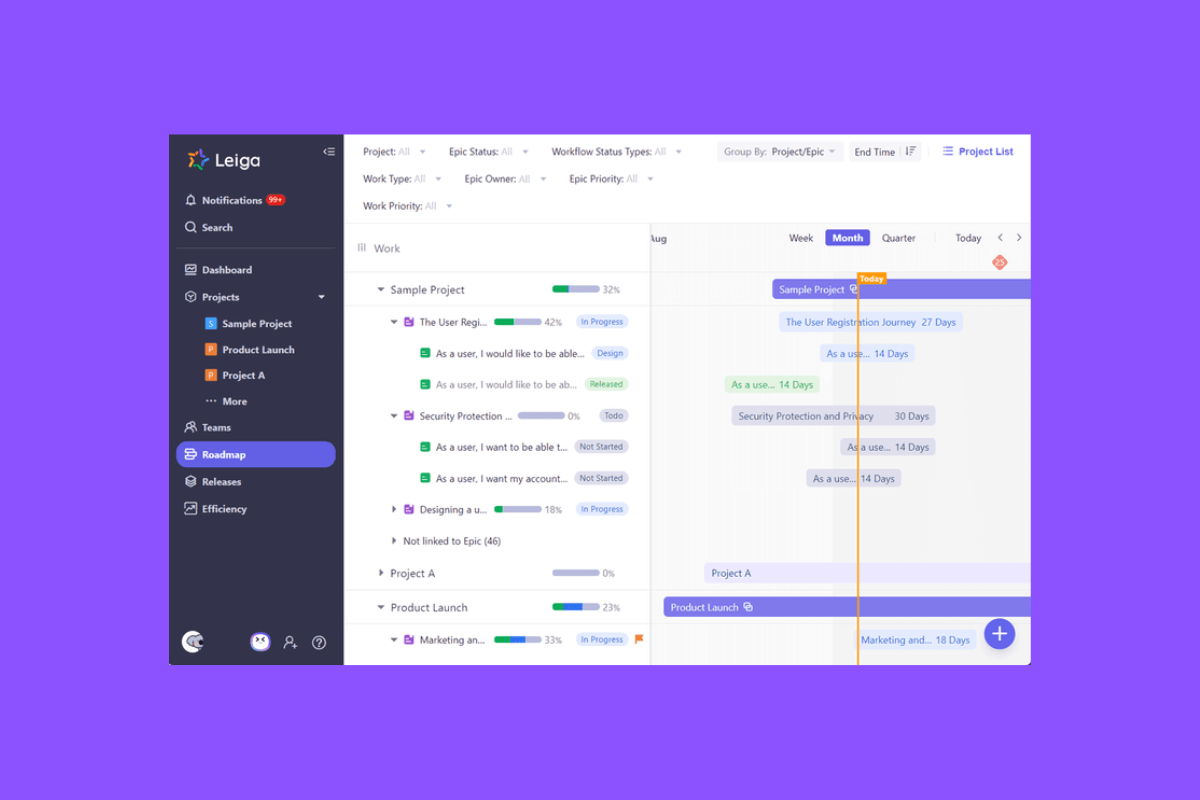
Turn Goals Into Measurable Impact With Leiga
What makes OKRs effective is not just setting goals that define the success you want to achieve. They foster better collaboration and accountability, while pushing your team to grow and get out of your comfort zone.
With a shift in mindset, adopting the best practices, and using effective tools, you can implement and manage OKRs effectively. Start with the basics: set inspiring high-impact objectives that are supported by measurable key results.
OKRs can turn your ambitions into actionable, measurable results. Teams should also keep in mind that achieving even a partial completion rate of ambitious goals drives more progress than easy, conventional goals.
Leiga helps teams do just that. It bridges the gap between goals and execution. From helping teams set OKRs to providing a platform for task tracking and even insight reports, Leiga provides unparalleled visibility and structure.
Stay aligned and focused with Leiga. Experience hassle-free task management and progress tracking with an AI-powered platform. Try it for free today to experience the difference it makes.
- Streamline Your Workflow with Leiga
- Effortlessly automate tasks
- Boost productivity with AI insights
- Free forever — elevate project management
